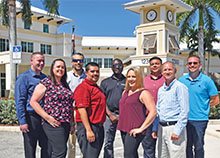Technology Services Department Keeps The Village Of Wellington Working At The Speed Of Business
Technology stretches across every facet of modern life. There are always new and innovative ways to use digital tools, which is a perfect way to describe the Village of Wellington’s Technology Services Department — commonly referred to as the “IT” department, short for the industry term “information technology.”
“It’s the 21st century, and we are the least visible but one of the most important departments because every single department is using some facet of mobile, tablet, laptop or desktop system to monitor things, record things, make alerts or create reports,” Chief Information Officer William Silliman explained. “More and more of the work is going less and less analog, so everything is pretty much digital nowadays.”
As times change, the IT department continues to integrate and upgrade every section of the village’s operations to improve the flow of work. As businesses and the community continue to develop more tech-savvy habits, Silliman’s seven-person team is on high alert at all times.
“The most critical issue I tell my staff is if e-mail, internet or telecommunications goes down, drop everything and figure it out,” Silliman said. “Security is also a big concern. We are constantly monitoring and watching everything from phishing scams to ransomware. We try and watch every little piece — making sure everything is backed up in a way that is recoverable.”
Technology Services continues on a strong path forward as they roll out improvements during a special three-year plan. The five-phase project includes upgrading the entire system to an Enterprise Resource Planning (ERP) software that streamlines everything for staff and residents from paying utility bills to building codes.
“Every iteration of the web site gets better as we try to keep it simple, friendly and easy to use,” Silliman said. “We’ve got a really great department and very smart people, and there is always something to improve. I don’t want IT to be a hole into which you pour money. We shop around, and with each innovation are working to save Wellington time and money. The key is we don’t perpetuate the way things have always been done.”
Perhaps one of the most striking changes to IT over the years is the integration of a quality Geographic Information Systems (GIS) team to support the village as a whole.
GIS Manager Nicole McPherson, who first worked for Wellington in 2004, returned home in 2010 to run an innovative team that is making big strides in the field and winning honors for creativity.
“We just received the 2019 Florida Excellence in Technology Award from the Agency for State Technology for our Emergency Operations GIS Portal,” McPherson said. “We have mobile apps collecting damage assessments that is connected to the FPL map of their outages and the county’s Emergency Operations Center (EOC).”
Essentially, this portal allows workers in the field after an emergency, like a hurricane or severe storm, to upload data including images and location information directly to the EOC. This allows senior staff to look at damage assessment information in as close to real time as possible, and decisions for dispatching repair teams and assistance is based on reality instead of speculation.
“Eventually, the idea is to have something publicly accessible so people can see real-time road closures and more after an emergency,” McPherson added. “Our team is awesome. I can’t do what I do without IT. They are so critical, and they don’t get the credit. I’ve had other people, including outside vendors, tell us our IT is amazing, and they are right.”
GIS is now a part of our everyday lives, whether we know it or not. Programs like Google Maps is one popular example of GIS in action, and IT is always finding new ways to use it.
“I used to challenge the team to think outside the box, and now I don’t have to — they just do it,” Silliman said. “I’ll play devil’s advocate and am always asking ‘what if’ so we can identify potential problems. Having redundancy means that the end users, both residents and village staff, don’t even know there was an issue.”
That’s all part of the department’s primary goal to always keep the machine running.
“Wellington uses a cloud-based system, so that it is not just reliant upon village hall being here. If it was gone to tomorrow, the data is still up and running, and you could go to a neighboring community and still function, pay bills and use the web site,” Silliman said.
In the grand scheme of a growing Wellington, IT is striving to ensure the least amount of impact for residents, businesses and employees. Having layers and backup plans in place allow Technology Services to keep the entire community connected and running smoothly.
After working in the private sector, and now at the village for the past seven years, Silliman feels more connected to his work than ever.
“I like the public sector. Being a resident here, I know who I’m working for, while in the private sector, I didn’t get to see the end user,” he said. “Instead, I’ve got the entire environment of Wellington. When we use a road application for surveys, I actually see the roads being paved. It just keeps going and growing each year.”
Silliman likes the fact that Wellington does not have a fear of technology, which is one thing that brought him to his current position.
“It’s one of the reasons why I came to Wellington,” he said. “While getting my water bill information filled out, I looked around and thought, ‘Wow, they’ve got a lot of technology.’ I pulled out my iPad, found a position and started applying right then and there.”
That was in the past, and thanks to Technology Services, Wellington is ready for the future.
